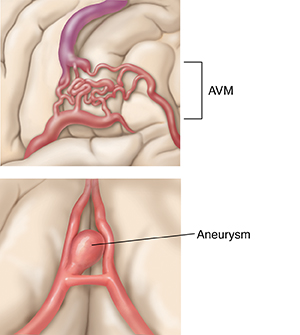A
B
C
D
E
F
G
H
I
J
K
L
M
N
O
P
Q
R
S
T
U
V
W
X
Y
Z
Click a letter to see a list of conditions beginning with that letter.
Click 'Topic Index' to return to the index for the current topic.
Click 'Library Index' to return to the listing of all topics.
When Your Child Has Intracranial Hemorrhage
Your child has an intracranial hemorrhage. This is bleeding that occurs in any part of the brain. Or between the brain and the skull. Bleeding can damage brain tissue. It can also lead to brain swelling or brain compression. If the bleeding is severe, treatment will be needed to limit brain damage or save your child’s life. Treatment may also reduce your child’s risk of having long-term brain (neurologic) problems.
What are the causes of intracranial hemorrhage?
Causes can include:
-
Trauma, such as a head injury
-
Problems with abnormal blood vessels in the brain, such as:
-
An abnormal formation of blood vessels (arteriovenous malformation)
-
A balloon-like bulge in the wall of a blood vessel in the brain (aneurysm)
-
Weakened blood vessels that occur with some brain tumors
-
Sickle cell disease
-
Diseases that make your child more prone to bleed, such as hemophilia or immune thrombocytopenia.
-
Disease of the brain blood vessels, such as Moyamoya disease.
-
Cancer
-
High blood pressure.
In up to 1 in 5 children, there is no cause.
 |
| Possible causes of intracranial hemorrhage include an arteriovenous malformation or an aneurysm. |
What are the symptoms of intracranial hemorrhage?
Symptoms can include:
-
Sudden, severe headache, ("worst headache of life.")
-
Dizziness or fainting
-
Trouble with vision, speech, or movement
-
Confusion, extreme irritability, or sudden personality change, or coma
-
Fever
-
Stiff neck or neck pain
-
Seizures or convulsions
-
Nausea and vomiting
How is intracranial hemorrhage diagnosed?
Intracranial hemorrhage is an emergency. Your healthcare provider will advise you to take your child to the closest emergency room if intracranial hemorrhage is suspected. Your child may be seen by a pediatric neurologist or neurosurgeon. These are healthcare providers with special training. They find and treat problems that affect the brain and nervous system. The healthcare provider will ask about your child’s health history and symptoms. The healthcare provider will also examine your child. Tests will be done too. These can include:
-
MRI or CT scan. These give detailed pictures of the brain. They are used to help check for bleeding. During the test, fluid called contrast dye may be used to make the blood vessels and brain easier to see.
-
Angiography. This test takes pictures of the blood vessels in the brain. During the test, a thin tube called a catheter is guided into the blood vessels leading to the brain. Contrast dye is sent through the tube. This is to make the blood vessels easier to see. This test can also be done with an MRI or CT scan.
-
Transcranial doppler. This test shows the flow of blood through the blood vessels in the brain. It uses harmless sound waves to form pictures of the brain and blood vessels. It's used to keep track of ongoing conditions that may make the bleeding worse.
-
Blood tests. Blood tests are done to find risk factors. The tests include platelet count and other tests to measure blood clotting.
How is intracranial hemorrhage treated?
Treatment depends on the cause, size, and location of the bleeding. It also depends on your child’s overall health and whether the pressure within your child's brain is higher than normal. Treatment can include:
-
Observation. Small amounts of bleeding will reabsorb on their own. This does not need surgery. Your child may need to be observed in the hospital. This is to watch for symptoms of bleeding that gets worse.
-
Medicines. Medicines may be used to control the bleeding, prevent seizures, control blood pressure, and ease intracranial pressure.
-
Surgery. This may be done to remove trapped blood, treat abnormal blood vessels, remove a tumor, or drain excess fluid in the brain. It's also done to lower the intracranial pressure.
-
Repair of abnormal blood vessels in the brain. This may involve surgery to clip or remove the abnormal blood vessel. Or a catheter can be used to insert glue, a coil, or a balloon into the abnormal blood vessel. This closes it off. This also helps reduce the risk of further bleeding.
What are the long-term concerns?
Each child’s outcome will vary depending on the size, cause, and location of the bleeding. It also depends on when treatment is done if the intracranial pressure is higher than normal. Some children don't have any problems after treatment. Other children may have ongoing nervous system problems. These can include trouble with learning, speech, or movement. Some develop seizures or epilepsy. In these cases, regular follow-up with the healthcare provider is needed. Supportive care, such as speech, physical, or occupational therapy, may also be needed.
Online Medical Reviewer:
Anne Fetterman RN BSN
Online Medical Reviewer:
Raymond Kent Turley BSN MSN RN
Online Medical Reviewer:
Scott Aydin MD
Date Last Reviewed:
12/1/2022
© 2000-2024 The StayWell Company, LLC. All rights reserved. This information is not intended as a substitute for professional medical care. Always follow your healthcare professional's instructions.